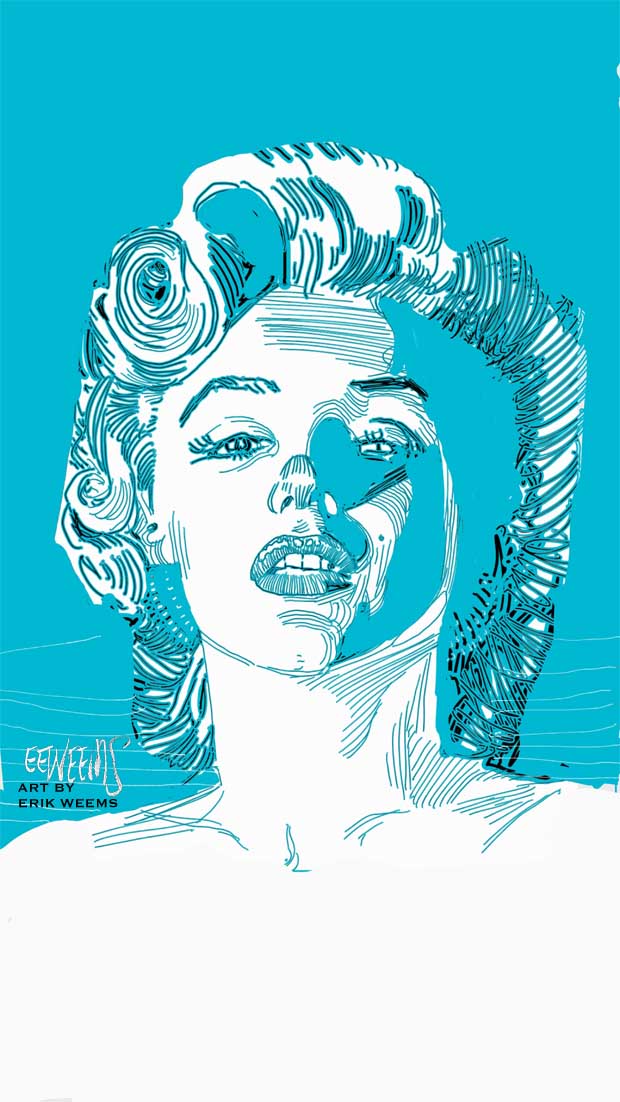Marilyn Monroe
June 1, 1926 - August 5, 1962 - Born Norma Jeane Mortenson
"Famous" hardly covers the matter with Norma Jeane / Marilyn Monroe. Lionized in pop songs, movies, TV shows, books, comic books (and more) she has not faded in recognition like the vast bulk of stars from her era have, but instead is probably as well known now, if not better known, than she was during the height of her career. Simply put, just about every expression of pop culture that there is has had Marilyn Monroe added to it at one time or another, and her influence on female identity (and the phantasy depiction of it produced in visual media like her movies and TV Shows) is mammoth.
Movies
At times she was well directed in movies, sometimes not. Sometimes she's shown as effective, nearly-sympathetic but vicious (Niagara, 1953), or as an air-headed but well-meaning voluptuary with savvy-street smarts, at least in regards to men and toothpaste (Seven Year Itch, 1955), or a street-level product of the school of hard knocks (Bus Stop, 1956).
An otherwise brilliant comedy director like Billy Wilder didn't know what to do except use her as an almost animalistic visual prop in Some Like it Hot, 1959, a film that reaches for satire and irony (and lifts many elements from Preston Sturges' 1942 film The Palm Beach Story) but then Wilder gets lost amplifying Monroe like a visualized multiplication table. Wilder's film is probably the zenith of the cartoon of Monroe, where she ends up playing her own parody (and then that parody gets amplified further by Jayne Mansfield in several of her films).
But Monroe had graduated from just wanting to be in films to wanting to matter in movies. The John Huston film Misfits (1961) is a well made film and puts Monroe forward as a real person with real aspirations. Its well-written (Arthur Miller wrote it and constantly revised it as it was being made on location in Nevada, trying to get the best possible script), the film has perfect black and white photography, and staffed with enough talent for any number of good films (Clark Gable, Montgomery Clift, Eli Walloch, Thelma Ritter). Though touted as a very good film by movie critics in the decades since its dismal box office performance in 1961, Monroe herself came to dislike the film and the character she portrayed in it. Which begs the question, what kind of character would Monroe have been glad to present onscreen? After Misfits, she was involved in gestating a film that was never completed (Somethings Got to Give, partially shot with Dean Martin) and a list of other films (including another with Billy Wilder) which were only talked about and salary numbers finalized before she died in 1962.

Popularity
As an industry and personality, she produces new crops of fans regularly who keep her memory alive and use her for multiple purposes: role model, idol, warning. Her life story generates sympathy (abuse at a young age, and raw manipulation during her film career within the Hollywood studio system) and though she died young (36) she is often viewed as a heroic woman who fought to have independence and strength of identity that many modern 21st century women want.
It is hard to say in the 21st century whether her popularity is even built on her movie career, or if she is simply one of those rare personalities that are self-generating within the confines of pop reality, always a touch stone and prototype, creating imitators who keep the basic outlines alive and current, and when they fade out the original gets promulgated all over again, fresh and new.
Antecedents
Although a unique movie star, she had many antecedents, at times seeming like a combination of the teenage Shirley Temple, Ann Sheridan, Veronica Lake and Rhonda Fleming, and that's just scratching the surface. Her onscreen portrayals patch together elements of Mae West to Susan Hayward, but she simplifies all of it, creating ambiguity that allows movie goers to interject what they wanted to be there, for good or ill, something that the most peculiarly gifted of the Hollywood performers could do.
An inveterate movie watcher while growing up, Monroe synthesized her impression of whatever a movie star actress is and combined it with her own natural talents. She had an instinct for what she might be able to get away with in a time when cultural rules and stigmas were changing, and she played for sympathy in many roles while simultaneously being the object of desire. It was a money-making system, though whether she was even aware of the formula in those terms is doubtful.
The 430 Books in Marilyn Monroe's Library Open Culture
What's Recent
- Island of Desire - 1951
- Road to Morocco
- The Devil and Miss Jones - 1941
- Sinners - 2025
- Something for the Boys - 1944
- The Mark of Zorro - 1940
- The Woman They Almost Lynched - 1953
- The Cat Girl - 1957
- El Vampiro - 1957
- Adventures of Hajji Baba – 1954
- Shanghai Express 1932
- Pandora's Box – 1929
- Diary of A Chambermaid - 1946
- The City Without Jews - 1924
- The Long Haul
- Midnight, 1939
- Hercules Against the Moon Men, 1964
- Send Me No Flowers - 1964
- Raymie - 1964.
- The Hangman 1959
- Kiss Me, Deadly - 1955
- Dracula's Daughter - 1936
- Crossing Delancey - 1988
- The Scavengers – 1959
- Mr. Hobbs Takes A Vacation - 1962
- Jackpot – 2024
- Surf Party - 1964
- Cyclotrode X – 1966
Original page March 2014 - Updated June 2023
